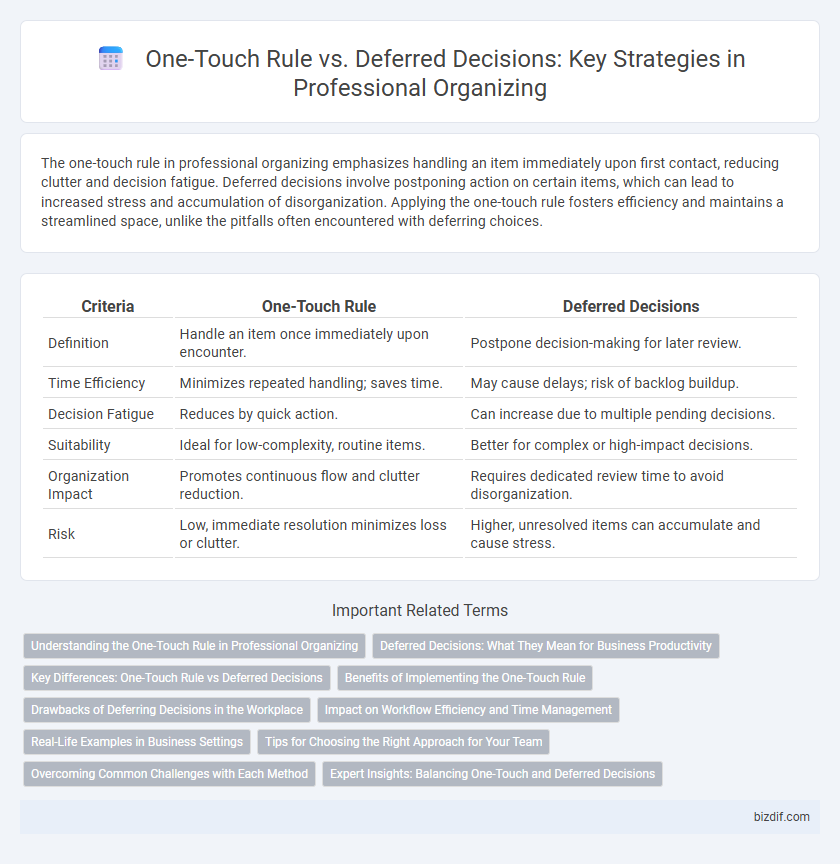The one-touch rule in professional organizing emphasizes handling an item immediately upon first contact, reducing clutter and decision fatigue. Deferred decisions involve postponing action on certain items, which can lead to increased stress and accumulation of disorganization. Applying the one-touch rule fosters efficiency and maintains a streamlined space, unlike the pitfalls often encountered with deferring choices.
Table of Comparison
| Criteria | One-Touch Rule | Deferred Decisions |
|---|---|---|
| Definition | Handle an item once immediately upon encounter. | Postpone decision-making for later review. |
| Time Efficiency | Minimizes repeated handling; saves time. | May cause delays; risk of backlog buildup. |
| Decision Fatigue | Reduces by quick action. | Can increase due to multiple pending decisions. |
| Suitability | Ideal for low-complexity, routine items. | Better for complex or high-impact decisions. |
| Organization Impact | Promotes continuous flow and clutter reduction. | Requires dedicated review time to avoid disorganization. |
| Risk | Low, immediate resolution minimizes loss or clutter. | Higher, unresolved items can accumulate and cause stress. |
Understanding the One-Touch Rule in Professional Organizing
The One-Touch Rule in professional organizing emphasizes handling an item only once by deciding immediately whether to keep, discard, or relocate it, enhancing efficiency and reducing clutter. Unlike deferred decisions that postpone action and often lead to pile-ups or decision fatigue, the One-Touch Rule streamlines workflow and promotes consistent organizational habits. Implementing this rule helps maintain clear spaces and accelerates the organizing process by minimizing repetitive handling.
Deferred Decisions: What They Mean for Business Productivity
Deferred decisions in professional organizing refer to postponing immediate actions to prioritize critical tasks, enhancing overall workflow efficiency. By strategically delaying less urgent choices, businesses reduce cognitive overload, enabling focused attention on high-impact projects that drive productivity. Implementing this approach fosters clearer prioritization and resource allocation, ultimately leading to more effective task management and improved organizational outcomes.
Key Differences: One-Touch Rule vs Deferred Decisions
The One-Touch Rule emphasizes immediate action on tasks, reducing clutter and enhancing efficiency by handling items once during a single encounter. Deferred Decisions involve postponing tasks to a later time, which can lead to a buildup of incomplete actions and increased cognitive load. Key differences include the impact on productivity, with the One-Touch Rule promoting quick resolution, while Deferred Decisions require effective time management to avoid procrastination.
Benefits of Implementing the One-Touch Rule
Implementing the one-touch rule in professional organizing significantly reduces clutter by handling each item immediately, preventing piles of unattended tasks. This rule accelerates decision-making and boosts productivity, as items are either filed, discarded, or delegated on first contact. Adopting this method streamlines workflow and fosters an organized, efficient environment.
Drawbacks of Deferring Decisions in the Workplace
Deferring decisions in the workplace often leads to increased stress and decreased productivity as pending tasks accumulate and create mental clutter. The One-touch rule, which advocates for immediate action on tasks, prevents backlog and supports efficient time management by minimizing procrastination. Prolonged deferment can also cause missed deadlines and reduced team accountability, ultimately hindering organizational performance.
Impact on Workflow Efficiency and Time Management
Applying the one-touch rule in professional organizing enhances workflow efficiency by minimizing clutter and reducing decision fatigue, allowing tasks to be completed promptly. Deferred decisions can lead to bottlenecks, increasing mental load and disrupting time management through prolonged task completion. Prioritizing immediate action on items streamlines processes and optimizes productivity in organizing systems.
Real-Life Examples in Business Settings
Implementing the one-touch rule in business settings enhances productivity by immediately addressing emails and tasks, reducing clutter and preventing backlog. Deferred decisions, such as scheduling time for strategic planning or complex problem-solving, allow business leaders to prioritize critical thinking without interruption. Real-life examples show companies like IBM using the one-touch rule for routine communications, while Google allocates specific times for deferred decisions to foster innovation and deep work.
Tips for Choosing the Right Approach for Your Team
Implement the one-touch rule to boost efficiency by handling tasks immediately, minimizing clutter and decision fatigue for your team. Use deferred decisions strategically when tasks require additional information or collaboration to ensure accuracy and quality outcomes. Assess your team's workflow, complexity of tasks, and communication preferences to choose the approach that enhances productivity and reduces bottlenecks.
Overcoming Common Challenges with Each Method
The one-touch rule streamlines task completion by encouraging immediate action, reducing clutter and decision fatigue but can struggle with complex or time-intensive tasks needing more thought. Deferred decisions allow for thoughtful planning and prioritization but risk procrastination and task backlog, requiring disciplined review schedules to maintain progress. Balancing these methods involves assessing task urgency and complexity to apply swift resolution or scheduled evaluation, optimizing productivity and organization efficacy.
Expert Insights: Balancing One-Touch and Deferred Decisions
Expert insights emphasize that balancing the one-touch rule and deferred decisions enhances productivity in professional organizing by reducing clutter and mental overload. The one-touch rule advocates immediate action on items, minimizing procrastination, while deferred decisions allow thoughtful evaluation for complex or unclear tasks. Effective organizers recommend integrating both methods to optimize workflow and maintain organizational clarity.
One-touch rule vs Deferred decisions Infographic

 bizdif.com
bizdif.com